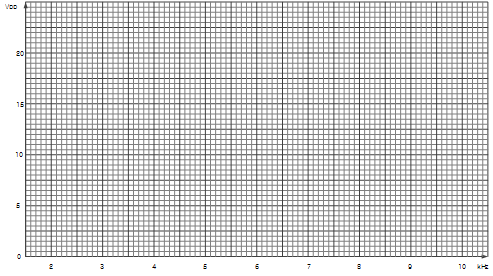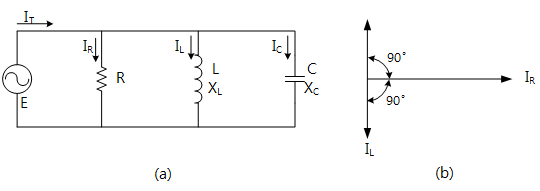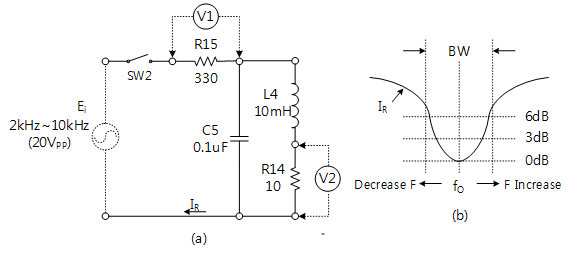PART1R, L, C Circuit
Experiment 19 :Parallel Resonant Circuit
Theory
As in fig.1-32(a), when R, L, C elements are connected in parallel, the size and phase of their AC combined resistance, that is, the impedance Z are as below.
Impedance : 
Size : 
Phase : 
In L-C parallel circuit, at the frequency of ω0C = 1/ ω0L, the impedance Z has pure resistance only, and the frequency here becomes resonant frequency. The angular frequency satisfying this condition becomes ω0 = 1/ √ LC, and this ω0 is resonant angular frequency, and the resonant frequency f0 is f0 = 1/ 2π√ LC. Q(quality factor) at parallel resonant circuit is defined as Q = f0 / (f2 - f1) just as serial resonant circuit, and expressed as Q = ω0CR = R1(ω0L). That is, Q is proportional to R. Fig.1-32(b) shows the graph expressing the relationship between resonant frequency and the current at parallel resonant circuit.
Experiment Process
1. In Block j of M01, connect Function Generator, oscilloscope or AC voltmeter as in fig.1-33(a).
2. Make the sine wave output of Function Generator as 20Vp-p, and change the frequency from 2kHz to 10kHz by 200Hz interval to record the output voltage V in table 1-19.
Find the frequency that becomes 0dB(resonant frequency), -3dB and -6dB and record the result in the relevant column.
Make R15 resistance shorted and measure the voltage value applied to R14 and record the result in the relevant column of table 1-19.
tab1Experiment 1-19.1 Process RLC Parallel Resonant Circuit (Compose as in fig.1-33)
1.Connection
1.Function Generator Connection
Connect between A+ terminal of Signal Input CH A on front panel and SW3 left terminal of Block j with red line, and between A- terminal and left terminal of C5 with black line.
2.Measuring Instrument(Voltmeter) Connection
V1 Measurement: Connect between A+ terminal of Signal Input CH A on front panel and lower terminal of R15 of Block j with red line, and between A- terminal and upper terminal of R15 with black line.
V2 Measurement: Connect between B+ terminal of Signal Input CH B on front panel and right terminal of R14 of Block j with red line, and between B- terminal and left terminal of R14 with black line.
2.Wiring Diagram
3.Measurement
- 1Choose analog output at left menu of front panel.
In Function Generator window, set up Amplitude as , Frequency as , Signal as and click to set up as 2kHz. Click to output 2KHz 20Vp-p.
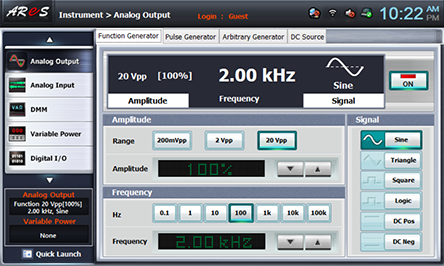
- 2Click analog input at left menu of Touch LCD panel.
Choose Volt & Ampere Meter tab and click , , for CH A, CH B and then the measured value is indicated. Record in the relevant column of table 1-19. CH A is V1(voltage between R15’s both ends), and CH B is V2(voltage between R14’s both ends)
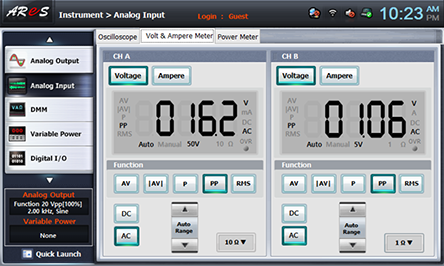
Make R15 resistance shorted and measure and record the voltage value applied to R14.
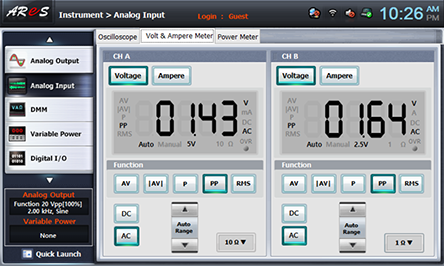
- 3Change the frequency as in table 1-19 and measure and record the result in the relevant column.
Choose quick launch at lower part of left menu on Touch LDC panel and click Analog Output.
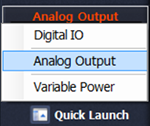
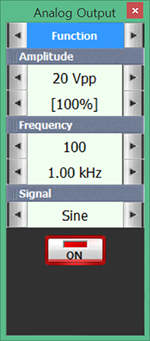
Click on the right of Frequency 100Hz and increase the frequency by 200Hz and record the measured value in CH A and CH B of Volt & Ampere Meter in the relevant column of table 1-19.
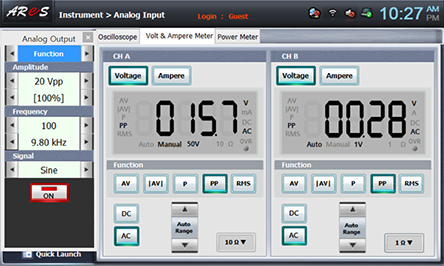
Make R15 resistance shorted and measure and record the voltage value applied to R14.

- 4After the measurement, click to cut off the output of function generator.
Experiment Result Report
1. Experiment Result Table
※ V2’is the V2 voltage when R15 is shorted.
2. Review and Explanation
1) Calculate the resonant frequency using table 1-19 above and draw the graph below and compare it with the resonant frequency.
